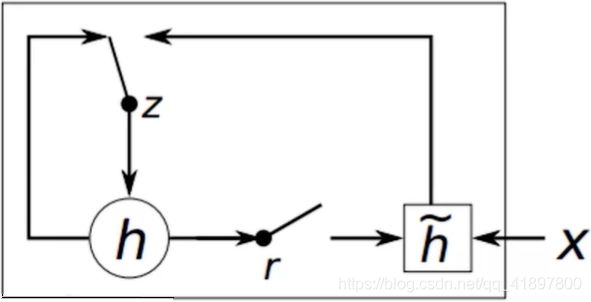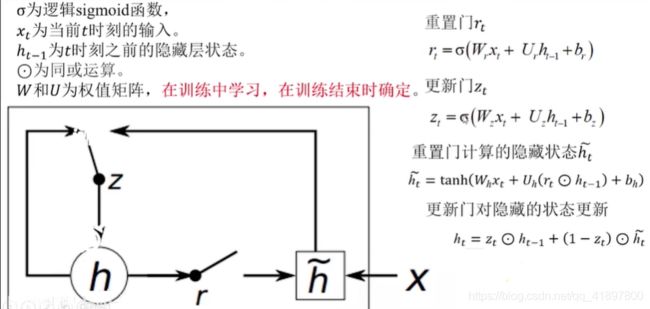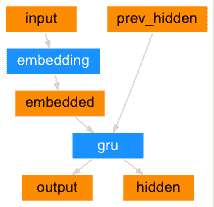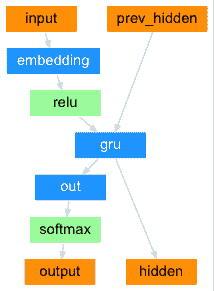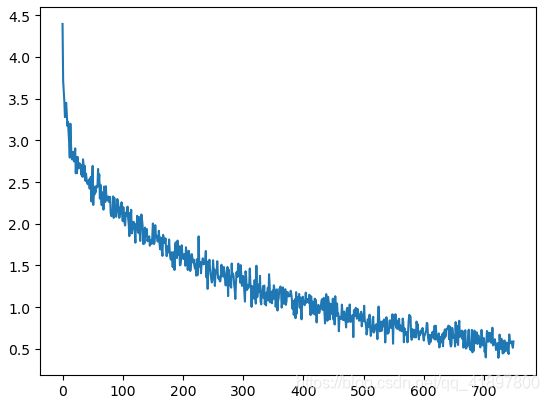【PyTorch】6 法语英语翻译RNN实战——基于Attention的seq2seq模型、Attention可视化
基于注意力机制的 seq2seq 神经网络翻译
- 1. 本文工作
- 2. 加载数据文件
- 3. Seq2Seq 模型
- 4. GRU
- 5. 准备训练数据
- 6. 编码器
- 7. 解码器
-
- 7.1 简单解码器
- 7.2 Attention解码器
- 8. 训练模型
- 9. 评价
- 10. 可视化注意力
- 11. 全部代码
- 小结
这是官方NLP From Scratch的一个教程(3/3),原中文链接,在这个项目中,我们将搭建神经网络,将法语翻译成英语,本文是其详细的注解
1. 本文工作
编码器网络将输入序列压缩为一个向量,而解码器网络将该向量展开为一个新序列
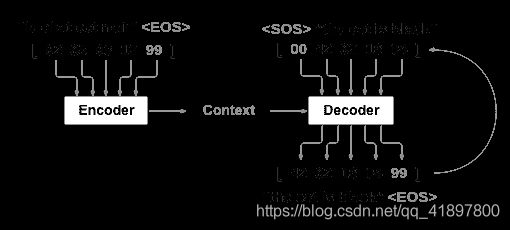
改进此模型,使用注意机制,该机制可让解码器学习将注意力集中在输入序列的特定范围内
2. 加载数据文件
需要加载名为’data/eng-fra.txt’的文件
这其实也是one-hot编码,但与之前所有字母中可能存在的几十个字符相比,单词有很多,因此编码向量要大得多。 这里作弊并整理数据以使每种语言仅使用几千个单词
首先创建函数:
def readLangs(lang1, lang2, reverse=False)
读文件进来,发现有一些:\u202f这种符号,所以再创建函数:
def normalizeString(s)
进行标准化,看一下re库的这两个函数用法:
s = 'I love you!?,'
s = re.sub(r"([.!?])", r" \1", s)
print(s)
s = re.sub(r"[^a-zA-Z.!?]+", r"6", s)
print(s)
I love you ! ?,
I6love6you!?6
生成的pairs就是:
[...['plastic surgery alone will not make you any less ugly .', 'la chirurgie plastique seule ne vous rendra pas moins laid .']...]
如果需要其他语言 → 英语,可以用reversed()函数,返回的是一个反转的迭代器,需要使用list()函数,原理如下:
x = ['plastic surgery alone will not make you any less ugly .', 'la chirurgie plastique seule ne vous rendra pas moins laid .']
pairs = list(reversed(x))
print(pairs)
['la chirurgie plastique seule ne vous rendra pas moins laid .', 'plastic surgery alone will not make you any less ugly .']
没有list就是:
<list_reverseiterator object at 0x000001C5A3399820>
希望为每个单词创建一个唯一的索引,定义一个类class Lang,该类具有单词→索引(word2index)和索引→单词(index2word)字典,以及每个要使用的单词word2count的计数,以便以后替换稀有词
在这里,最大长度为 10 个字(包括结尾的标点符号),并且过滤翻译成“i’m”或“he’s”等形式的句子(考虑到前面已替换掉撇号的情况)
关于startswith(str, beg=0,end=len(string))函数,用于检查字符串是否是以指定子字符串开头,如果是则返回 True,否则返回 False。如果参数 beg 和 end 指定值,则在指定范围内检查
这里直接把原文prepareData函数写道主函数里面,原文默认英语→其他语言,但是它两次的结果演示都是其他语言 → 英语,所以默认reverse=True才对:
print("Counted words:")
print(input_lang.name, input_lang.n_words)
print(output_lang.name, output_lang.n_words)
print(random.choice(pairs))
Counted words:
fra 4345
eng 2803
['il fait une promenade .', 'he is taking a walk .']
3. Seq2Seq 模型
序列到序列网络或 seq2seq 网络或编码器解码器网络是由两个称为编码器和解码器的 RNN 组成的模型,编码器读取输入序列并输出单个向量,而解码器读取该向量以产生输出序列
与使用单个 RNN 进行序列预测(每个输入对应一个输出)不同,seq2seq 模型使我们摆脱了序列长度和顺序的限制,这使其非常适合在两种语言之间进行翻译
例如:Je ne suis pas le chat noir(我不是黑猫)单个词的百度翻译:
- Je 我
- ne NE公司
- suis 跟踪
- pas 没有
- le 在
- chat 猫
- noir 黑色
输入句子中的大多数单词在输出句子中具有直接翻译,但是顺序略有不同,例如 “chat noir”和“black cat”,由于采用“ ne / pas”结构,因此在输入句子中还有一个单词。 直接从输入单词的序列中产生正确的翻译将是困难的
使用 seq2seq 模型,编码器创建单个矢量,在理想情况下,该矢量将输入序列的“含义”编码为单个矢量-句子的某些 N 维空间中的单个点
4. GRU
先来看一下门控循环单元(gated recurrent unit, GRU)
参考此视频
LSTM门控网络结构过于复杂与冗余
GRU将遗忘门和输入门合并成更新门,同时将记忆单元与隐藏层合并成了重置门,进而让整个结构运算变得更加简化且性能得以增强。
当重置门接近于0时,隐藏状态被迫忽略先前的隐藏状态,仅用当前输入进行复位
这有效地使隐藏状态可以丢弃将来以后发现不相关的任何信息,从而允许更紧凑的表示
另一方面,更新门控制从前一个隐藏状态将有多少信息转移到当前隐藏状态。这类似于LSTM网络中的记忆单元,并有助于RNN记住长期信息
5. 准备训练数据
对于每一对,我们将需要一个输入张量(输入句子中单词的索引)和目标张量(目标句子中单词的索引),创建这些向量时,将 EOS 令牌附加到两个序列上
对于pairs[0],即['j ai ans .', 'i m .'],由tensorFromPair(pair)函数返回的input_tensor为:
tensor([[2],
[3],
[4],
[5],
[1]], device='cuda:0')
其大小为torch.Size([5, 1]),target_tensor为:
tensor([[2],
[3],
[4],
[1]], device='cuda:0')
其大小为torch.Size([4, 1])
6. 编码器
seq2seq 网络的编码器是 RNN,它为输入句子中的每个单词输出一些值。 对于每个输入字,编码器输出一个向量和一个隐藏状态,并将隐藏状态用于下一个输入字
7. 解码器
解码器是另一个 RNN,它采用编码器输出矢量并输出单词序列来创建翻译
7.1 简单解码器
在最简单的 seq2seq 解码器中,我们仅使用编码器的最后一个输出。 最后的输出有时称为上下文向量,因为它对整个序列的上下文进行编码。 该上下文向量用作解码器的初始隐藏状态,在解码的每个步骤中,为解码器提供输入令牌和隐藏状态。 初始输入令牌是字符串开始,第一个隐藏状态是上下文向量(编码器的最后一个隐藏状态)
7.2 Attention解码器
如果仅上下文向量在编码器和解码器之间传递,则该单个向量承担对整个句子进行编码的负担,Attention使解码器网络可以针对解码器自身输出的每一步,“专注”于编码器输出的不同部分。 首先,我们计算一组Attention权重。 将这些与编码器输出向量相乘以创建加权组合。 结果(在代码中称为attn_applied)应包含有关输入序列特定部分的信息,从而帮助解码器选择正确的输出字
计算注意力权重的方法是使用另一个前馈层attn,并使用解码器的输入和隐藏状态作为输入。 由于训练数据中包含各种大小的句子,因此要实际创建和训练该层,我们必须选择可以应用的最大句子长度(输入长度,用于编码器输出)。最大长度的句子将使用所有注意权重,而较短的句子将仅使用前几个
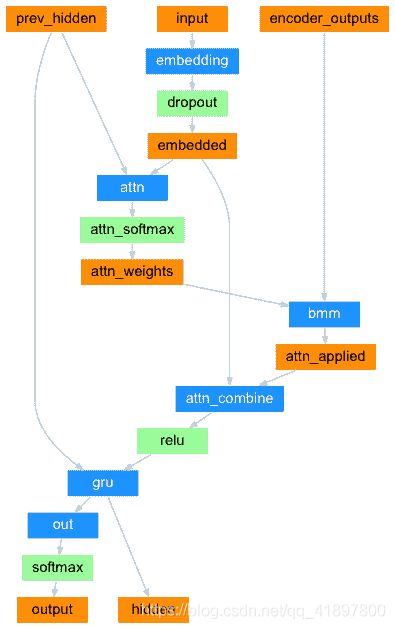
关于:
torch.bmm()是tensor中的一个相乘操作,类似于矩阵中的A*B,input(p,m,n) * mat2(p,n,a) ->output(p,m,a),前一个矩阵的列等于后面矩阵的行才可以相乘,例如:
import torch
x = torch.rand(2,3,6)
y = torch.rand(2,6,7)
print(torch.bmm(x,y).size())
torch.Size([2, 3, 7])
8. 训练模型
为了进行训练,我们通过编码器运行输入语句,并跟踪每个输出和最新的隐藏状态。 然后,为解码器提供SOS_TOKEN令牌作为其第一个输入,并将编码器的最后一个隐藏状态作为其第一个隐藏状态
“教师强制”的概念是使用实际目标输出作为每个下一个输入,而不是使用解码器的猜测作为下一个输入。 使用教师强制会导致其收敛更快,但是当使用受过训练的网络时,可能会显示不稳定
您可以观察到以教师为主导的网络的输出,这些输出阅读的是连贯的语法,但却偏离了正确的翻译-直观地,它学会了代表输出语法,并且一旦老师说了最初的几个单词就可以“理解”含义,但是,它还没有正确地学习如何从翻译中创建句子
由于 PyTorch 的 autograd 具有给我们的自由,我们可以通过简单的 if 语句随意选择是否使用教师强迫。 调高teacher_forcing_ratio以使用更多功能
再看一下:
x = torch.rand(2,3,4)
print(x)
topv, topi = x.topk(1)
print(topv, topi)
tensor([[[0.9181, 0.4981, 0.9914, 0.2432],
[0.6078, 0.0700, 0.5814, 0.1134],
[0.5261, 0.4351, 0.7423, 0.5492]],
[[0.4094, 0.0585, 0.6755, 0.5136],
[0.2214, 0.1035, 0.8093, 0.9017],
[0.3362, 0.2959, 0.6774, 0.8712]]])
tensor([[[0.9914],
[0.6078],
[0.7423]],
[[0.6755],
[0.9017],
[0.8712]]]) tensor([[[2],
[0],
[2]],
[[2],
[3],
[3]]])
关于
x = torch.rand(1, 2560)
topv, topi = x.topk(1)
print(topi)
print(topi.squeeze()) # 将输入张量形状中的1 去除并返回,如果输入是形如(A×1×B×1×C×1×D),那么输出形状就为: (A×B×C×D)
print(topi.squeeze().detach()) # 返回一个新的Tensor,从当前图中脱离出来,该tensor不会要求更新梯度,也就是梯度在这中断了
print(topi.squeeze().detach().item())
tensor([[1217]])
tensor(1217)
tensor(1217)
1217
关于绘图,原代码把纵轴的间隔设成了0.2:
import matplotlib.pyplot as plt
plt.switch_backend('agg')
import matplotlib.ticker as ticker
import numpy as np
def showPlot(points):
plt.figure()
fig, ax = plt.subplots()
# this locator puts ticks at regular intervals
loc = ticker.MultipleLocator(base=0.2)
ax.yaxis.set_major_locator(loc)
plt.plot(points)
9. 评价
0.
> je suis mauvais aux echecs .
= i m terrible at chess .
< i am a chess chess . <EOS>
1.
> c est un tres bon joueur de tennis .
= he is a good tennis player .
< he is a good tennis player . <EOS>
2.
> elle porte de l ombre a paupiere .
= she s wearing eye shadow .
< she s wearing her birth . <EOS>
3.
> je suis ravi de votre travail .
= i m very pleased with your work .
< i m pleased your your work . <EOS>
4.
> je suis creatif .
= i m creative .
< i m thorough . <EOS>
10. 可视化注意力
注意机制的一个有用特性是其高度可解释的输出。 因为它用于加权输入序列的特定编码器输出,所以我们可以想象一下在每个时间步长上网络最关注的位置。
可以简单地运行plt.matshow(attentions)以将注意力输出显示为矩阵,其中列为输入步骤,行为输出步骤

为了获得更好的观看体验,我们将做一些额外的工作来添加轴和标签,关于cmap的使用可见此:
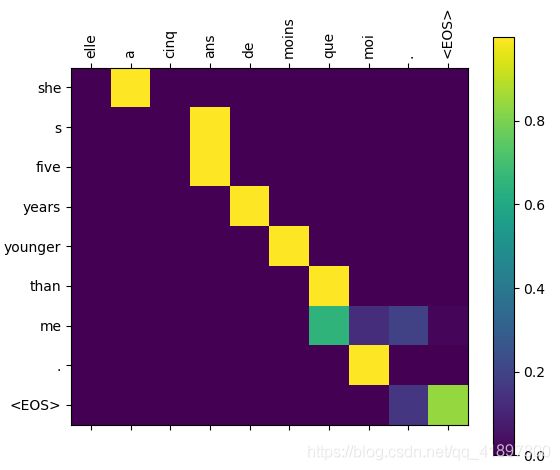
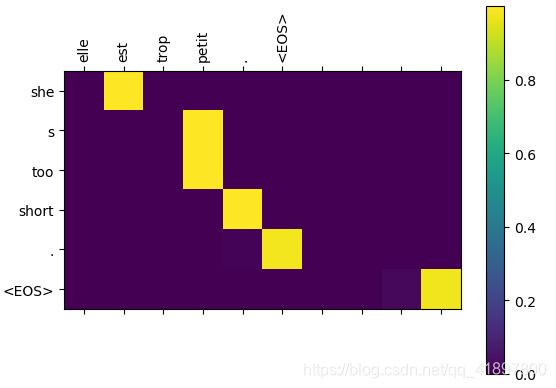
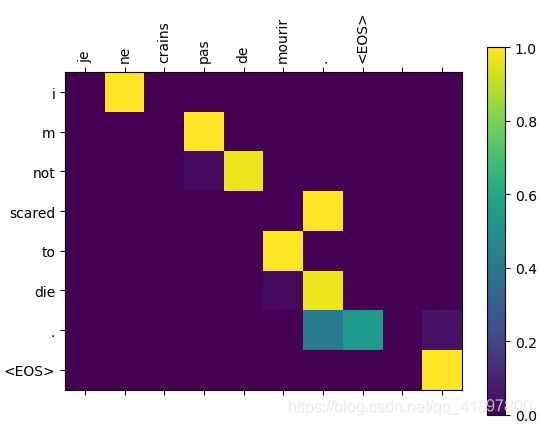
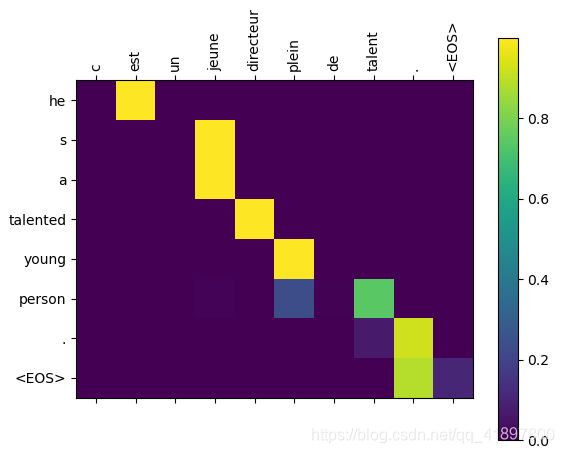
input = elle a cinq ans de moins que moi .
output = she s five years younger than me . <EOS>
input = elle est trop petit .
output = she s too short . <EOS>
input = je ne crains pas de mourir .
output = i m not scared to die . <EOS>
input = c est un jeune directeur plein de talent .
output = he s a talented young person . <EOS>
11. 全部代码
import unicodedata
import re
def normalizeString(s):
# 将 Unicode 字符转换为 ASCII
Ascii = []
for c in unicodedata.normalize('NFD', s):
if unicodedata.category(c) != 'Mn':
Ascii.append(c)
# 将ASCII列表转化为字符串,并将所有内容都转换为小写,并修剪大多数标点符号
s = ''.join(Ascii).lower().strip()
s = re.sub(r"([.!?])", r" \1", s) # 在.!?前面加上空格
s = re.sub(r"[^a-zA-Z.!?]+", r" ", s) # 只保留a-zA-Z.!?并在其后加空格
return s
SOS_token = 0 # Start of sentence
EOS_token = 1 # End of sentence
class Lang:
def __init__(self, name):
self.name = name
self.word2index = {
}
self.word2count = {
}
self.index2word = {
0: "SOS", 1: "EOS"}
self.n_words = 2
def addSentence(self, sentence):
for word in sentence.split(' '):
self.addWord(word)
def addWord(self, word):
if word not in self.word2index:
self.word2index[word] = self.n_words
self.index2word[self.n_words] = word
self.word2count[word] = 1
self.n_words += 1
else:
self.word2count[word] += 1
def readLangs(lang1='eng', lang2='fra', reverse=False): # 默认英语→其他语言,可以用reverse反转
print('Reading lines...')
file = open(path + 'eng-fra.txt', encoding='utf-8')
lines = file.read().strip().split('\n')
pairs = [[normalizeString(s) for s in l.split('\t')]for l in lines]
if reverse:
pairs = [list(reversed(i)) for i in pairs]
input_lang = Lang(lang2) # 初始化class里面的name
output_lang = Lang(lang1)
else:
input_lang = Lang(lang1)
output_lang = Lang(lang2)
return input_lang, output_lang, pairs
MAX_LENGTH = 10
eng_prefixes = (
"i am ", "i m ",
"he is", "he s ",
"she is", "she s ",
"you are", "you re ",
"we are", "we re ",
"they are", "they re "
)
def filterPair(pairs):
pair_filter = []
for p in pairs:
if len(p[0].split(' ')) < MAX_LENGTH and len(p[1].split(' ')) < MAX_LENGTH and p[1].startswith(eng_prefixes):
pair_filter.append(p)
return pair_filter
def tensorFromSentence(lang, sentence):
indexes = []
for word in sentence.split(' '):
indexes.append(lang.word2index[word])
indexes.append(EOS_token)
return torch.tensor(indexes, dtype=torch.long, device=device).view(-1, 1)
def tensorFromPair(pair):
input_tensor = tensorFromSentence(input_lang, pair[0])
target_tensor = tensorFromSentence(output_lang, pair[1])
return (input_tensor, target_tensor)
import torch
device = torch.device("cuda" if torch.cuda.is_available() else "cpu")
import torch.nn as nn
class EncoderRNN(nn.Module):
def __init__(self, input_size, hidden_size): # input_lang.n_words(4345), hidden_size=256
super(EncoderRNN, self).__init__()
self.hidden_size = hidden_size
self.embedding = nn.Embedding(input_size, hidden_size)
self.gru = nn.GRU(hidden_size, hidden_size) # embedding_dim=hidden_size, hidden_size, num_layers=1, bidirectional=False
def forward(self, input, hidden): # input.size()= torch.Size([1])
embedded = self.embedding(input).view(1, 1, -1) # 1 * hidden_size → 1 * 1 * hidden_size:torch.Size([1, 1, 256])
output = embedded
output, hidden = self.gru(output, hidden)
return output, hidden
def initHidden(self):
return torch.zeros(1, 1, self.hidden_size, device=device) # num_layers * num_directions, batch, hidden_size
# 简单解码器
import torch.nn.functional as F
# class DecoderRNN(nn.Module):
# def __init__(self, hidden_size, output_size):
# super(DecoderRNN,self).__init__()
# self.hidden_size = hidden_size
#
# self.embedding = nn.Embedding(output_size, hidden_size)
# self.gru = nn.GRU(hidden_size, hidden_size)
# self.out = nn.Linear(hidden_size, output_size)
# self.softmax = nn.LogSoftmax(dim=1)
#
# def forward(self, input, hidden):
# output = self.embedding(input).view(1, 1, -1)
# output = F.relu(output)
# output, hidden = self.gru(output, hidden)
# output = self.softmax(self.out(output[0]))
# return output, hidden
#
# def initHidden(self):
# return torch.zeros(1, 1, self.hidden_size, device=device)
# Attention 解码器
class AttnDecoderRNN(nn.Module):
def __init__(self, hidden_size, output_size, dropout_p=0.1, max_length=MAX_LENGTH):
super(AttnDecoderRNN, self).__init__()
self.hidden_size = hidden_size
self.output_size = output_size
self.dropout_p = dropout_p
self.max_length = max_length
self.embedding = nn.Embedding(self.output_size, self.hidden_size)
self.dropout = nn.Dropout(self.dropout_p)
self.attn = nn.Linear(self.hidden_size * 2, self.max_length)
self.attn_combine = nn.Linear(self.hidden_size * 2, self.hidden_size)
self.gru = nn.GRU(self.hidden_size, self.hidden_size)
self.out = nn.Linear(self.hidden_size, self.output_size)
def forward(self, input, hidden, encoder_outputs):
embedded = self.embedding(input).view(1, 1, -1) # 1 * 1 * 256
embedded = self.dropout(embedded)
attn_weights = F.softmax(
self.attn(torch.cat((embedded[0], hidden[0]), 1)), dim=1 # (1 * 256与1 * 256) → Linear 1 * 10
)
attn_applied = torch.bmm(attn_weights.unsqueeze(0),encoder_outputs.unsqueeze(0)) # 1 * 1 * 10, 1 * max_length * encoder.hidden_size → 1 * 1 * 256
output = torch.cat((embedded[0], attn_applied[0]), 1) # 1 * 512
output = self.attn_combine(output).unsqueeze(0) # 1 * 1* 256
output = F.relu(output)
output, hidden = self.gru(output, hidden)
output = F.log_softmax(self.out(output[0]), dim=1)
return output, hidden, attn_weights
def initHidden(self):
return torch.zeros(1, 1, self.hidden_size, device=device)
from torch import optim
teacher_forcing_ratio = 0.5
def train(input_tensor, target_tensor, encoder, decoder, encoder_optimizer, decoder_optimizer, criterion, max_length=MAX_LENGTH):
encoder_hidden = encoder.initHidden()
encoder_optimizer.zero_grad()
decoder_optimizer.zero_grad()
input_length = input_tensor.size()[0]
target_length = target_tensor.size()[0]
encoder_outputs = torch.zeros(max_length, encoder.hidden_size, device=device)
loss = 0
for ei in range(input_length):
encoder_output, encoder_hidden = encoder(input_tensor[ei], encoder_hidden)
encoder_outputs[ei] = encoder_output[0][0]
decoder_input = torch.tensor([SOS_token], device=device)
decoder_hidden = encoder_hidden
use_teacher_forcing = True if random.random() < teacher_forcing_ratio else False
if use_teacher_forcing: # Learn from reference
for di in range(target_length):
decoder_output, decoder_hidden, decoder_attention = decoder(decoder_input, decoder_hidden, encoder_outputs)
loss += criterion(decoder_output, target_tensor[di]) # 1 * output_size
decoder_input = target_tensor[di] # Teacher forcing
else: # Learn from model
for di in range(target_length):
decoder_output, decoder_hidden, decoder_attention = decoder(decoder_input, decoder_hidden, encoder_outputs)
loss += criterion(decoder_output, target_tensor[di])
topv, topi = decoder_output.topk(1)
decoder_input = topi.detach() # detach from history as input
if decoder_input.item() == EOS_token:
break
loss.backward()
encoder_optimizer.step()
decoder_optimizer.step()
return loss.item() / target_length
import random
import matplotlib.pyplot as plt
def trainIters(encoder, decoder):
start = time.time()
n_iters = 75000
print_every = 1000
plot_every = 100
print_loss_total = 0 # Reset every print_every
plot_loss_total = 0 # Reset every plot_every
encoder_optimizer = optim.SGD(encoder.parameters(), lr=0.01)
decoder_optimizer = optim.SGD(decoder.parameters(), lr=0.01)
training_pairs = [tensorFromPair(random.choice(pairs)) for i in range(75000)] # n_iters
criterion = nn.NLLLoss()
plot_losses = []
for iter in range(1, n_iters + 1):
training_pair = training_pairs[iter - 1]
input_tensor = training_pair[0]
target_tensor = training_pair[1]
loss = train(input_tensor, target_tensor, encoder, decoder, encoder_optimizer, decoder_optimizer, criterion)
print_loss_total += loss
plot_loss_total += loss
if iter % print_every == 0:
print_loss_avg = print_loss_total / print_every
print_loss_total = 0
print('{} 当前iter={} 完成进度{:.3f}% Loss:{:.4f}'.format(timeSince(start, iter / n_iters), iter, iter / n_iters * 100, print_loss_avg))
if iter % plot_every == 0:
plot_loss_avg = plot_loss_total / plot_every
plot_loss_total = 0
plot_losses.append(plot_loss_avg)
torch.save(encoder.state_dict(), '... your path\\model_encoder.pth')
torch.save(decoder.state_dict(), '... your path\\model_decoder.pth')
plt.figure()
plt.plot(plot_losses)
plt.show()
import time
import math
def asMinutes(s):
m = math.floor(s / 60)
s -= m * 60
return '%dm %ds' % (m, s)
def timeSince(since, percent): #用于在给定当前时间和进度%的情况下打印经过的时间和估计的剩余时间
now = time.time()
s = now - since
es = s / (percent)
rs = es - s
return '运行时间 %s (估计的剩余时间 %s)' % (asMinutes(s), asMinutes(rs))
def evaluate(encoder, decoder, sentence):
max_length = MAX_LENGTH
encoder.load_state_dict(torch.load('... your path\\model_encoder.pth'))
decoder.load_state_dict(torch.load('... your path\\model_decoder.pth'))
with torch.no_grad():
input_tensor = tensorFromSentence(input_lang, sentence)
input_length = input_tensor.size()[0]
encoder_hidden = encoder.initHidden()
encoder_outputs = torch.zeros(max_length, encoder.hidden_size, device=device)
for ei in range(input_length):
encoder_output, encoder_hidden = encoder(input_tensor[ei], encoder_hidden)
encoder_outputs[ei] += encoder_output[0][0]
decoder_input = torch.tensor([[SOS_token]], device=device)
decoder_hidden = encoder_hidden
decoder_words = []
decoder_attentions = torch.zeros(max_length, max_length)
for di in range(max_length):
decoder_output, decoder_hidden, decoder_attention = decoder(decoder_input, decoder_hidden, encoder_outputs)
decoder_attentions[di] = decoder_attention.data
topv, topi = decoder_output.data.topk(1)
if topi.item() == EOS_token:
decoder_words.append('' )
break
else:
decoder_words.append(output_lang.index2word[topi.item()])
decoder_input = topi.detach()
return decoder_words, decoder_attentions[:di+1]
def evaluateRandomly(encoder, decoder, n=5):
for i in range(n):
pair = random.choice(pairs)
print(str(i) + '.')
print('>', pair[0])
print('=', pair[1])
decoder_words, decoder_attentions = evaluate(encoder1, attn_decoder1, pair[0])
print('<', ' '.join(decoder_words))
import matplotlib.ticker as ticker
def showAttention(input_sentence, output_words, attentions):
# 用色条设置图形
fig = plt.figure()
ax = fig.add_subplot(111)
cax = ax.matshow(attentions.numpy()) # colormap, cmap='bone'
fig.colorbar(cax)
# 设置轴
ax.set_xticklabels([''] + input_sentence.split(' ') + ['' ], rotation=90)
ax.set_yticklabels([''] + output_words)
# Show label at every tick
ax.xaxis.set_major_locator(ticker.MultipleLocator(1))
ax.yaxis.set_major_locator(ticker.MultipleLocator(1))
plt.show()
def evaluateAndShowAttention(input_sentence):
output_words, attentions = evaluate(encoder1, attn_decoder1, input_sentence)
print('input =', input_sentence)
print('output =', ' '.join(output_words))
showAttention(input_sentence, output_words, attentions)
if __name__ == '__main__':
path = '... your path\\'
# prepareData
input_lang, output_lang, pairs = readLangs(reverse=True)
print('Read %d sentence pairs' % len(pairs))
pairs = filterPair(pairs)
print('Trimmed to %d sentence pairs' % len(pairs))
for pair in pairs:
input_lang.addSentence(pair[0])
output_lang.addSentence(pair[1])
hidden_size = 256
encoder1 = EncoderRNN(input_lang.n_words, hidden_size).to(device)
attn_decoder1 = AttnDecoderRNN(hidden_size, output_lang.n_words, dropout_p=0.1).to(device)
# 以下为训练
# trainIters(encoder1, attn_decoder1)
# 以下为测试1
# sentence = 'vous etes avides .'
# decoder_words, decoder_attentions = evaluate(encoder1, attn_decoder1, sentence)
# print(' '.join(decoder_words))
# 以下为测试2
# evaluateRandomly(encoder1, attn_decoder1, n=5)
# 以下为注意力可视化1
# output_words, attentions = evaluate(encoder1, attn_decoder1, "je suis trop froid .")
# plt.matshow(attentions.numpy())
# plt.show()
# 以下为注意力可视化2
evaluateAndShowAttention("elle a cinq ans de moins que moi .")
evaluateAndShowAttention("elle est trop petit .")
evaluateAndShowAttention("je ne crains pas de mourir .")
evaluateAndShowAttention("c est un jeune directeur plein de talent .")
小结
- 本文主要实际应用了Attentions模型
- 本文件是一个英文文件,所以需要做一些希腊字母转化、标点符号转化、大小写问题处理,实际上处理的句子还是很有限的,只有I’m, It’s …这种
- seq2seq模型的编码器、解码器原理进一步清晰
- GRU原理简单入门,具体编程的话,输入输出的维度和LSTM应该是一样的吧
- 训练数据处理,能写成函数就写成函数,养成习惯
- Attention具体编程实现
- Attention可视化,和原文有一些出入,不过总的来说结果还可以

